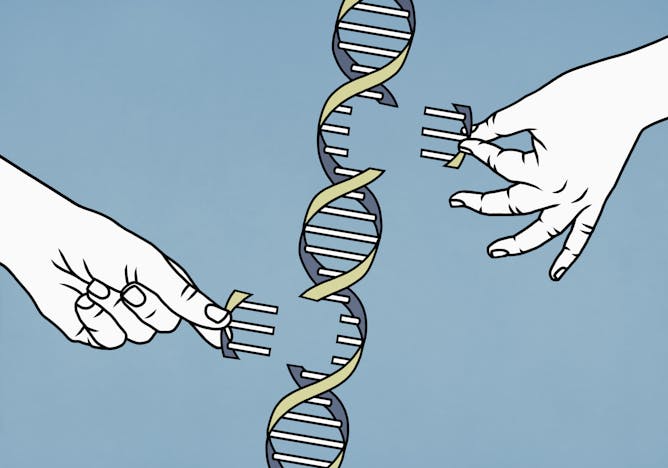|
Mapping out the billions of building blocks that make up our genetic code is no small feat. When the Human Genome Project first embarked on this project, technological limitations left researchers with large gaps in the final genetic sequence. By the end of the project in 2003, only 92% of the genome was actually complete – excluding stretches of repetitive DNA segments of unclear function.
Scientists published that remaining 8% yesterday. And now, they can put that genetic “dark matter” under the microscope.
Gabrielle Hartley of the University of Connecticut was part of the team of scientists that helped uncover these repetitive sequences. She explains how these missing pieces fit into the genomic puzzle of the human body, and how the repetitive regions that make up so much of our genetic code shape health, evolution and which genes are turned on or off. The work, she writes, could yield not only a better understanding of the fundamentals of biology but also insights into genetic diseases.
Also today:
|

|
Vivian Lam
Assistant Health and Biomedicine Editor
|
|

Over half of the human genome contains repetitive DNA sequences whose functions are still not fully understood.
Malte Mueller/fStop via Getty Images
Gabrielle Hartley, University of Connecticut
Advances in technology have enabled researchers to sequence the large regions of repetitive DNA that eluded the Human Genome Project.
|
Politics + Society
|
-
Alexander Hinton, Rutgers University - Newark
There are a few warning signs that genocide is happening. In the Russian war on Ukraine, all of those are present.
-
Mitchell G. Klingenberg, United States Army War College
A career soldier and a careful scholar of the military profession, William Tecumseh Sherman knew that wars are part of human nature, and are unavoidably cruel and harsh.
|
|
Education
|
-
Arik Burakovsky, Tufts University
Decades of collaboration between Western and Russian universities have come to a halt because of the war in Ukraine. An expert on U.S.-Russia relations explains what’s at stake.
|
|
Economy + Business
|
-
Scott L. Montgomery, University of Washington
The total release could reach 180 million barrels over six months, which would make it the biggest in the history of the Strategic Petroleum Reserve.
|
|
Health + Medicine
|
-
Jennifer Borland, Oklahoma State University
This illustrated health manual dating back to the 13th century provides a glimpse of daily life in aristocratic households during the Middle Ages.
-
Gabriel Lockett, University of Florida; Jules Sostre, University of Florida; Roberto L. Abreu, University of Florida
Being both trans and a person of color comes with a unique set of challenges. Collectively working toward overcoming these barriers is one way this community fights for survival.
-
Michael Williams, University of Virginia
The constantly changing COVID-19 rules can be frustrating. But this pandemic is like no other public health crisis in history. It is better to think of the virus and US responses the way we think about hurricanes.
|
|
Ethics + Religion
|
-
Charles J. Russo, University of Dayton
The Supreme Court will hear oral arguments in Kennedy v. Bremerton School District, a case stemming from a football coach’s prayers on the field, on April 25, 2022.
-
Mohammad Hassan Khalil, Michigan State University
Muslims observe a month-long fast for the holy month of Ramadan. A scholar explains the religious observance and its spiritual significance.
|
|
Podcast 🎙️
|
-
Gemma Ware, The Conversation; Daniel Merino, The Conversation; Carissa Lee, The Conversation
Plus, new research into how the COVID-19 pandemic is affecting the lives of young people born into poverty around the world.
|
|
From our international editions
|
|
|
|
The Conversation Quiz 🧠 |
|---|
About how many people in the U.S. have alopecia areata, or hair loss to a particular area?
- A. 330 thousand
- B. 750 thousand
- C. 1 million
- D. 1.5 million
Click here for the answer. -
| More from The Conversation US |
|---|
| |
|
| |
| |
| |
| |
|
|